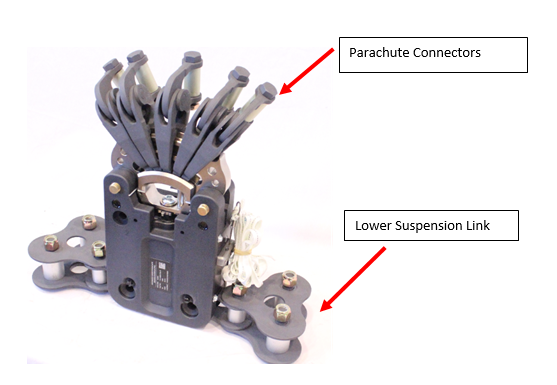 ACPRS Air Drop Operations (courtesy photo)
ACPRS Air Drop Operations (courtesy photo)
The Advanced Cargo Parachute Release System (ACPRS), NSN 1670-01-608-4698, will replace the M1, NSN 1670-01-095-8816, and M2, NSN 1670-01-097-8817, Cargo Parachute Release Systems, over a time-phased transition. The ACPRS is more reliable, operates in all weather conditions, and automatically disengages the recovery parachutes from the load at impact regardless of wind conditions. That prevents damage that results from dragging and protects anyone assigned to recover the load.
Here are some considerations to keep in mind as the ACPRS is fielded:
Unit Supply
As part of the transition, the ACPRS will be transitioning from the Common Table of Allowances (CTA) to the Modified Table of Equipment (MTOE). This means authorized users will be required to manage ACPRS on organizational property books. In order for sustainment commands to produce the ACPRS, users will need build demand by placing orders thru the Army supply system.
Unit Maintenance
To ensure cargo reaches the ground safely, a current and qualified 92R, parachute rigger is responsible for the inspection and maintenance of the ACPRS.
After receiving a new ACPRS and before rigging, the 92R must inspect the unit for damage following all the inspection and maintenance procedures in TM 10-1670-296-20&P (Oct 02). During the inspection, check for damage to the parachute release. Operate the release to make sure it works.
For tracking purposes, assign a test item number to the ACPRS, the lower suspension links and the parachute connectors. Document any damage or problems in a technical information report (TIR). ADD Form 1473, Report Documentation Page, containing an abstract of the publication is forwarded to the Defense Technical Information Center (DTIC) within 10 work days of the release of the original publication.
 Inspect ACPRS when received
Inspect ACPRS when received
Once the ACPRS passes inspection, the rigging process and automated testing of the unit takes about 40 minutes with two qualified 92Rs. Remember that attention to detail is the key to success in avoiding damage to the load and injury to others.
Battery Ordering and Charging Tips
The ACPRS battery is sold separately. Users should order the battery assembly using NSN 6140-01-609-7775.
 Order ACPRS battery separately
Order ACPRS battery separately
Here are two charging tips:
1. To maximize battery life, users should charge the battery every three (3) months in accordance with TM 10-1670-296-20&P (Oct 02).
2. Storing batteries outside of the ACPRS greatly extends battery life.
When not in use, ensure the arming wire is inserted on the ACPRS. If the battery is installed and the arming wire isn’t inserted, the battery will discharge and result in battery failure.
 Install arming wire to prevent battery failure
Install arming wire to prevent battery failure